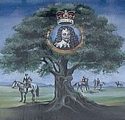Out the days of the escape, Charles made nine journeys over seventeen active days and covered an estimated 441 miles, nearly all of it on horseback. These are the journeys:
| Coverage | Date(s) [number of days] | Mileage per google maps | Mode | Assumed identity | Accompanied by: | |
|---|---|---|---|---|---|---|
| 1 | Post battle Worcester to White Lades Priory, near Boscobel House | 3 September 1651 [1] | 41 | Horse | Himself | Lord Wilmot, Swan, Lord Derby, Giffard, Francis Yates I plus other officers |
| 2 | Boscobel loop White Ladies to Madeley Hall and back to Boscobel. | 4-5 September 1651 [2] | 23 | Foot | Woodsman, Will Jones | Richard Penderel |
| 3 | Moseley trip Boscobel to Moseley Old Hall | 7 September 1651 [1] | 9 | Humphrey Penderel's mill-horse | Will Jones | The Penderel brothers plus Francis Yates II |
| 4 | Bentley trip Moseley Old Hall to Bentley Hall | 9 September 1651 [1] | 7 | Horse | Will Jones | Lord Wilmot, Swan, John Penderel, Colonel Lane |
| 5 | Cotswold journey Bentley Hall to Old Leigh Court | 10-12 September 1651 [3] | 96 | Horse | William Jackson, servant to Jane Lane | Wilmot, Swan, both riding ahead; Jane Lane, Henry Lascelles |
| 6 | Trent Manor Journey Old Leigh Court to Trent Manor | 16-17 September 1651 [2] | 50 | Horse | William Jackson, servant to Jane Lane | Wilmot, Swan, Jane Lane, Henry Lascelles |
| 7 | Charmouth loop Trent Manor to Charmouth, then to Bridport, Broadwindsor and back to Trent | 22-24 September 1651 [3] | 60 | Horse | William Jackson, servant to Wilmot who himself was posing as a runaway bridegroom | Wilmot, Swan, Francis Wyndham, Henry Peters and Juliana Coningsby |
| 8 | Heale House Journey Trent Manor to Heale House | 6 October 1651 [1] | 45 | Horse | William Jackson | Phelips, Henry Peters and Juliana Coningsby |
| 9 | To Shoreham and away | 13 - 15 October 1651 [3] | 110 | Horse | William Jackson | Firstly Phelips, later Wilmot, Swan and Gunter |
| [Total days on the road - 17] | Total mileage - 441 |
The horse question
I must confess, I have a nagging doubt about these mileages (pun intended). That is, could the horses possibly have completed these journeys in the time apparently taken? I am informed that 20 miles a day is good going, 30 just barely possible. But Charles was frequently doing more than this. Was he perhaps changing horses? During that time, officers or messengers in a hurry would often change horses at local farms, inns and plantations, perhaps every twelve-fifteen miles, leaving behind their original horse and a receipt. Sometimes they would return the way they came, retrieving their original mount. Other times, they would not return but send the borrowed mount back with someone else. Only messengers and high ranking officers and staff traveled quickly enough to require rotations, so relying on citizens was a reasonable practice.
That would seem to be the answer and would explain the fairly frequent references to refreshment stops; however, there are two thngs against this:
- At Charmouth, Wilmot’s horse was recognised as being from the Midlands as it had a shoe that originated in Worcestershire. So, if this is true, he must have used the same horse throughout.
- Secondly and more generally, the party would have been anxious to avoid scrutiny – so would not have wanted to draw attention to themselves by leaving a trail of witnesses to their movements.
So the answer is – I don’t know. Any suggestion on a postcard please.

